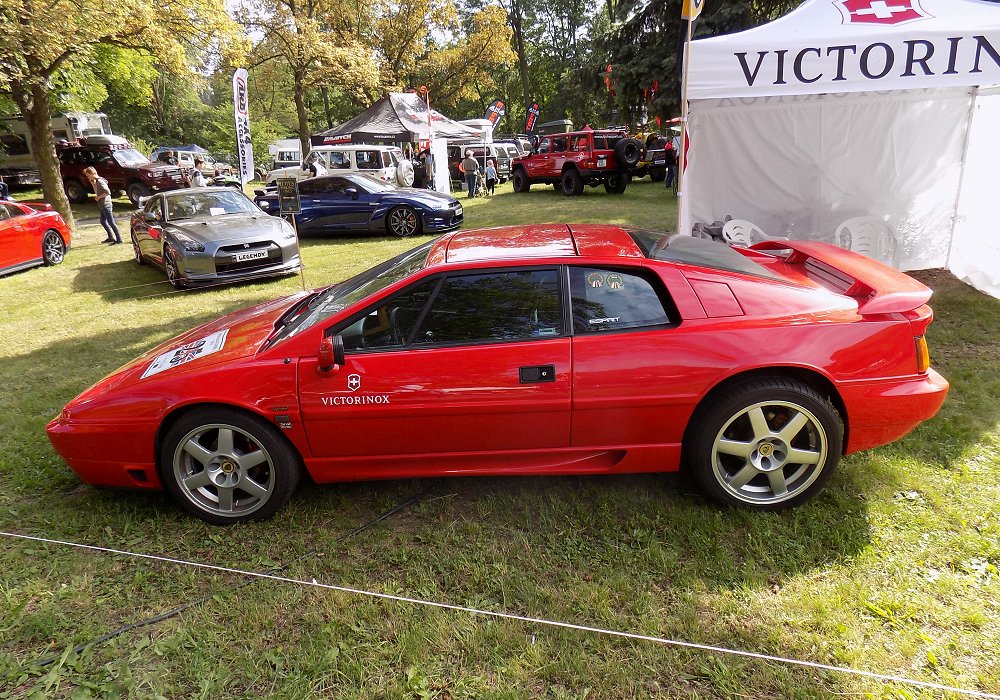Description
The Lotus Esprit Turbo SE was introduced in 1989 and marked one of the most significant steps forward in the car’s long and continuous evolution. Building upon the success of the earlier Turbo models and incorporating the smoother Peter Stevens redesign of 1987, the Turbo SE elevated the Esprit into genuine supercar territory. It combined a revised, more powerful version of the turbocharged four-cylinder engine with aerodynamic refinements, improved interior comfort, and a higher level of build quality. The result was a car that not only delivered thrilling performance but also brought a new sense of polish and maturity to the Esprit range.
Power came from the Lotus Type 910S engine, a 2.2-litre all-aluminium, sixteen-valve, twin-cam four-cylinder unit now fitted with a Garrett T3/60 turbocharger and an air-to-water chargecooler system developed directly from Lotus’s Formula One experience. The addition of the chargecooler, which reduced the temperature of the intake air before it entered the cylinders, allowed for more efficient combustion and greater power output without sacrificing reliability. In this form, the engine produced around 264 horsepower and 280 lb-ft of torque, giving the car a dramatic increase in performance over previous versions. Mated to a five-speed Renault gearbox, the Esprit Turbo SE could accelerate from 0 to 60 mph in just 4.7 seconds and reach a top speed of 160 mph, firmly placing it among the top-performing supercars of its era.
The Turbo SE’s chassis was based on the same steel backbone structure used throughout the Esprit’s life but featured additional strengthening and improved suspension geometry. Lotus engineers fitted revised springs, dampers, and anti-roll bars, striking a careful balance between handling precision and long-distance comfort. The result was exceptional road-holding, with the Esprit SE capable of high cornering speeds and remarkable stability even on uneven surfaces. The steering remained unassisted but was quick, accurate, and full of feedback — a hallmark of Lotus design. Ventilated disc brakes at all four corners provided strong stopping power, while Goodyear Eagle VR50 tyres were developed in partnership with Lotus specifically for the car to ensure optimal grip and response.
Visually, the Turbo SE retained the smooth, flowing shape introduced in 1987 but added a number of distinctive aerodynamic and cosmetic touches. The front bumper was redesigned with deeper intakes and a lower air dam, while a large rear wing improved downforce at speed. The body featured integrated side skirts and subtly flared wheel arches, giving the car a wider, more planted stance. The styling combined elegance with aggression, maintaining the Esprit’s unmistakable wedge profile while softening some of the earlier Giugiaro-era angularity. The Turbo SE badge and unique alloy wheel designs distinguished it from the naturally aspirated Esprit models, and the car’s proportions remained strikingly low and sleek, even by late-1980s standards.
Inside, the Turbo SE reflected Lotus’s determination to move the Esprit upmarket. The cabin was hand-trimmed in fine leather with improved ergonomics and instrumentation. The dashboard featured more modern switchgear, clear analogue gauges, and higher-quality fittings than earlier models. The seats were supportive and adjustable, and amenities such as air conditioning, electric windows, and premium audio were standard equipment. While still intimate in size, the interior ambience was more refined, making the Turbo SE a car equally suited to spirited driving and grand touring.
On the road, the Esprit Turbo SE delivered an experience that combined raw performance with finesse. The turbocharged engine offered smooth, progressive power delivery, with the chargecooler ensuring consistent performance even under sustained high-speed driving. The car’s balance and mid-engine layout gave it exceptional agility, while the steering provided a level of feel and precision unmatched by most rivals. Reviewers praised the SE for its ability to blend supercar speed with surprising practicality and everyday usability. It was capable of blistering pace on a track but also composed and tractable enough for regular road use.
The Esprit Turbo SE received widespread acclaim upon release and was seen as a major achievement for Lotus. It re-established the Esprit as a world-class performance car at a time when the brand faced stiff competition from Italy and Germany. In many ways, the SE represented the sweet spot in the Esprit’s long history — fast, reliable, beautifully balanced, and true to the company’s core philosophy of lightweight engineering.
Today, the Lotus Esprit Turbo SE is highly regarded among enthusiasts as one of the finest variants of the model. It combined the elegance of the Peter Stevens redesign with the excitement of the turbocharged four-cylinder engine at its most developed. With its balance of power, precision, and refinement, the Turbo SE stands as a definitive expression of Lotus engineering during the late 1980s — a car that embodied the marque’s belief that performance should come not from brute force but from intelligence, lightness, and perfect control.
